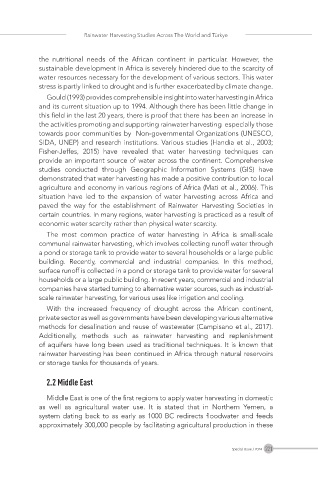Page 234 - Çevre Şehir ve İklim Dergisi İngilizce - Özel Sayı
P. 234
Rainwater Harvesting Studies Across The World and Türkye
the nutritional needs of the African continent in particular. However, the
sustainable development in Africa is severely hindered due to the scarcity of
water resources necessary for the development of various sectors. This water
stress is partly linked to drought and is further exacerbated by climate change.
Gould (1993) provides comprehensible insight into water harvesting in Africa
and its current situation up to 1994. Although there has been little change in
this field in the last 20 years, there is proof that there has been an increase in
the activities promoting and supporting rainwater harvesting especially those
towards poor communities by Non-governmental Organizations (UNESCO,
SIDA, UNEP) and research institutions. Various studies (Handia et al., 2003;
Fisher-Jeffes, 2015) have revealed that water harvesting techniques can
provide an important source of water across the continent. Comprehensive
studies conducted through Geographic Information Systems (GIS) have
demonstrated that water harvesting has made a positive contribution to local
agriculture and economy in various regions of Africa (Mati et al., 2006). This
situation have led to the expansion of water harvesting across Africa and
paved the way for the establishment of Rainwater Harvesting Societies in
certain countries. In many regions, water harvesting is practiced as a result of
economic water scarcity rather than physical water scarcity.
The most common practice of water harvesting in Africa is small-scale
communal rainwater harvesting, which involves collecting runoff water through
a pond or storage tank to provide water to several households or a large public
building. Recently, commercial and industrial companies. In this method,
surface runoff is collected in a pond or storage tank to provide water for several
households or a large public building. In recent years, commercial and industrial
companies have started turning to alternative water sources, such as industrial-
scale rainwater harvesting, for various uses like irrigation and cooling.
With the increased frequency of drought across the African continent,
private sector as well as governments have been developing various alternative
methods for desalination and reuse of wastewater (Campisano et al., 2017).
Additionally, methods such as rainwater harvesting and replenishment
of aquifers have long been used as traditional techniques. It is known that
rainwater harvesting has been continued in Africa through natural reservoirs
or storage tanks for thousands of years.
2.2 Middle East
Middle East is one of the first regions to apply water harvesting in domestic
as well as agricultural water use. It is stated that in Northern Yemen, a
system dating back to as early as 1000 BC redirects floodwater and feeds
approximately 300,000 people by facilitating agricultural production in these
221
Special Issue / 2024

